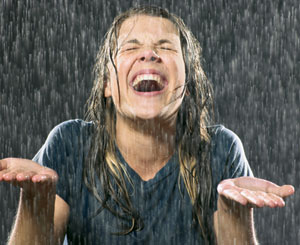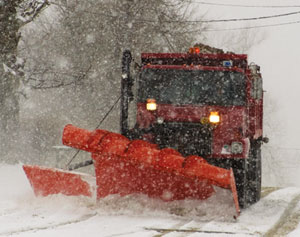 Editor’s note: This gem from our archives originally ran in the October 1978 issue.
Editor’s note: This gem from our archives originally ran in the October 1978 issue.
What is the potential damage to the woodwind instruments if your marching band gets caught in pouring rain? If your band performs a halftime show in sub-freezing weather, how will the brass instruments be affected? These are a few concerns that marching bands may face if the show must go on, despite bad weather. It is impossible to control the rain, lower the heat, or stop a blizzard, but you can minimize their damage by knowing how such weather may affect instruments and musicians. Test your ability to cope with the weather by answering these true/false questions. Then compare your responses to the answers which follow.
1. T F As the temperature drops, intonation becomes more and more of a problem.
2. T F Cold, dry weather does not harm woodwind instruments.
3. T F After exposure to cold, dry weather, wooden clarinets and oboes should be quickly warmed to room temperature.
4. T F Clarinet, flute, and saxophone pads are not affected by a rain soaking.
5. T F In excessive heat, clarinet, flute, and saxophone pads may fall out.
6. T F Steel rods, pivot screws, and springs on woodwind instruments may rust from a rain soaking.
7. T F There’s nothing you can do to prevent valves from freezing in below-freezing weather.
8. T F A metal mouthpiece, if it’s cold enough, can freeze to a brass player’s lips.
 9. T F Brass instruments are not affected by rain.
9. T F Brass instruments are not affected by rain.
10. T F Stainless steel drums with plastic heads are not affected by rain, freezing temperatures, and heat.
11. T F Extreme weather is as much of a problem for players as it is for their instruments.
Scroll down for answers.
Answers
1. True. Changing weather can blitzkrieg your best tuning efforts. James Phillips, associate director of bands at the University of Notre Dame, recalls what happened at the 1974 Sugar Bowl: “The temperature during the afternoon dress rehearsal was in the high 70s. By game time in the evening, we were beset with extreme wind and rain. The temperature had dropped 40 degrees to the high 30s.”
The intonation problem in a situation like this occurs because falling temperatures cause the instrument materials to shrink, enlarging the size of the bore and making it play flatter. Minor intonation problems occur indoors with only slight changes in temperature and humidity. These small changes can cause a one- or two-thousandths of an inch difference in the size of a clarinet bore. Severe weather outdoors can cause changes in bore size of from four- to seven-thousandths of an inch. Temperature changes like this make tuning very difficult.
2. False. After a few hours of exposure to cold, dry weather, you might hear these complaints from your woodwind players: “My instrument won’t play,” “These keys are stuck,” or “I can’t stop squeaking.” As cold temperatures cause the instrument material to shrink, the keys on woodwinds may bind. These problems are most common in the larger woodwind instruments. The leather pads of saxophones also become brittle in freezing temperatures and may not seat properly when they warm again.
3. False. All wooden instruments should be brought to room temperature gradually after being exposed to the cold. A cold wooden instrument may crack if it is warmed too quickly, especially if the exposure was long enough for the cold to completely penetrate the wood. It is this tendency toward cracking that makes areas near heat ducts and radiators dangerous for wooden instruments.
4. False. Rain can affect clarinet, flute, and saxophone pads. The outer covering of a clarinet or flute pad is made from material which is resistant to moisture, but this is only true when the material is intact. If the covering is cracked or has a small hole, rain water can get into the felt core of the pad. The felt swells and may cause the pad to seat improperly on the rim of the tone hole. The thin leather pad of a saxophone also absorbs water easily. When the leather dries, it shrinks and may not seat properly.
5. True. Most of the glues used to hold clarinet, flute, and saxophone pads in their cups liquify when heated. Soaring temperatures in a locked car, bus, or storage trunk can soften the glue so that it will no longer hold the pad.
6. True. Steel springs and blued needle-steel springs, usually found on better quality woodwinds, will rust. Rods and pivot screws made of stainless steel won’t rust. Luckily, most student model instruments have stainless steel springs which will not rust or corrode.
7. False. Freezing valves are a problem in cold weather, but there is something you can do about it. With regular valve oil, the slightest bit of moisture in the valve casing can cause it to freeze. George Cavender, conductor of the University of Michigan Marching Band, says, “We have performed in ten-above-zero weather by replacing our regular valve oil with a mixture of equal parts of alcohol and glycerine. Store it in a clearly-labeled bottle — rubbing alcohol is toxic and flammable. Some of the new valve oils on the market work well in cold weather too. We tested one by applying the new valve oil and putting the instrument on a dormitory window ledge all night. It was cold, but it still worked.”
8. True. Metal mouthpieces can freeze to a brass player’s lips and this is a danger in very cold weather. Paul Droste, Ohio State University March-ing Band Director, made this suggestion: “I believe that plastic mouthpieces are a good idea for very cold weather, although we have never found one that played as well as our metal mouthpieces.”
9. False. Rain is not a great danger for brass instruments, but repeated or prolonged wetness may eventually affect the lacquer on the instrument. To avoid this, have your players wipe their instruments dry with a soft cloth after playing in the rain.
10. True. Stainless steel drums with plastic heads can withstand most of Mother Nature’s abuses. Only if temperatures near 200° (perhaps in storage or in transit) will plastic drum heads stretch slightly.
11. True. Musicians get as much wear and tear from the weather as their instruments. Robert Fleming, assistant director of bands at Arizona State University, knows this well. “At one game,” he said, “it was 102° at 7:30 p.m. and the temperature on the field was even higher. The band came off the field with sweat literally pouring out of their hats when they took them off.
“In hot country like this,” says Fleming, “you have to build up students’ resistance and prepare them for performing in this weather. We rehearse from a physical fitness standpoint. The beginning of each rehearsal consists of exercises that the football team physician and trainer have recommended.”
“Our rehearsal philosophy,” says Michigan’s George Cavender, “is, ‘It might be that way Saturday.’ So we rehearse in all kinds of bad weather. In early November one season, we had a storm that dumped three inches of ice and then eight inches of snow on the field. For the rest of November we couldn’t see the drill field. We got some coal dust and made black lines on the white field.”
What was it like marching on three inches of ice topped with eight inches of snow? “We didn’t march,” says Cavender. “We just shuffled.”
Score Yourself
The true score of your bad weather performance test comes at the end of the marching season – when you measure the morale of your band members against the condition of their instruments. One experienced band director whose band performed a halftime show in a torrent of thunder, lightning, and rain, said, “During the week after the soaking, I replaced 35 pads on clarinets alone, and we only march 10 clarinets. Despite the damage, our drenching was the talk of the season. As a result, morale couldn’t have been higher for the rest of the year.”





